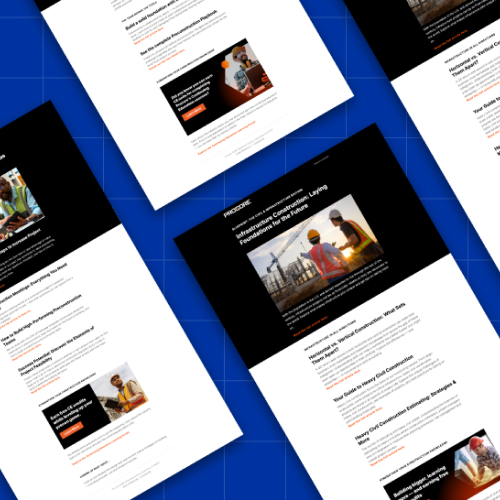— 10 min read
Crane Inspections: Preparing & Passing



Last Updated Nov 13, 2025

Clark Jensen
Strategic Product Consultant, Quality & Safety
10 articles
Clark Jensen joined Procore as a Senior Strategic Product Consultant, Quality & Safety where he spearheads product knowledge education and executes product demonstrations. He brings several years of experience in roles both on and offsite as a former senior project safety manager for a general contractor in Salt Lake City, and a senior risk control consultant for a large U.S.-based insurance firm.

Megan Duncan
Megan Duncan is an award-winning journalist based in Hannibal, Missouri. Her work has been featured on Muddy River News, Hannibal Courier-Post, The Whig, Hannibal Magazine, Q Magazine and Her View from Home. She has won two Best of Press Awards including first place from the Illinois Press Association for Localized National Story and third place from the Missouri Associated Press for best humor column. She holds a Bachelor of Arts in Communication from Quincy University.

Kristen Frisa
Contributing Writer
111 articles
Kristen Frisa is a contributing writer for Procore. She also contributes to a variety of industry publications as a freelance writer focused on finance and construction technology. Kristen holds a Bachelor of Arts in Philosophy and History from Western University, with a post-graduate certificate in journalism from Sheridan College. She lives in Ontario, Canada.
Last Updated Nov 13, 2025

When it comes to heavy lifting on construction sites, cranes are the real workhorses — towering over jobsites and hoisting materials upwards of 1,000 feet.
These giants should be kept in top-notch condition, which requires frequent inspections and updated records by site leadership and safety teams. Additionally, adhering to safety regulations and passing annual crane inspections are necessary to keep this heavy equipment in operation.
In this article, we’ll dive into what it takes to prepare for and pass annual crane inspections, and how to safely get cranes back into operation if they’ve been called out of service.
Table of contents
Types of Crane Inspections
Regular crane inspections are required to make sure the equipment is safe to operate. Annual inspections are only one of several types of inspections cranes may undergo as part of a comprehensive safety regimen. Other types of inspections include:
Initial Inspection
Conducted before a crane is put into service for the first time. This inspection ensures that the crane is installed and operating according to manufacturer specifications and safety standards.
Pre-Operational Inspection (Daily or Shift Inspection)
Performed by the crane operator or maintenance personnel at the beginning of each shift. This includes checking the crane's controls, hooks, chains, and other safety features to ensure everything is functioning correctly.
Frequent Inspection
Conducted monthly or quarterly, depending on the crane's usage and the environment in which it operates. These inspections focus on critical components and wear-prone parts such as brakes, ropes, and load chains.
Periodic Inspection
More comprehensive than frequent inspections, these are performed annually or biannually. They involve a detailed examination of the crane's overall condition, including structural components and mechanical systems.
Special/Ad Hoc Inspection
Conducted after unusual events such as accidents, natural disasters, or after significant modifications or repairs to the crane. These inspections ensure the crane is still safe to operate.
These inspections are crucial for maintaining crane safety and ensuring efficient operation. They help prevent accidents and extend the lifespan of the equipment.
Preparing for an Annual Crane Inspection
Yearly crane inspections serve as an audit of the safety checks and maintenance that should be conducted on a regular basis. Responsible equipment management, maintenance and clear and organized documentation help to lay the groundwork for a successful inspection.
Before scheduling the inspection, a third-party auditor may request the following information about the equipment:
- Crane capacity and height
- Manufacturer details
- Usage rates
- Presence of manlifts
- Site and safety protocols
Organize equipment documents.
Documents and logs should be readily available to provide to the third-party inspector. Any records taken throughout the year should be updated, organized and made easily accessible by site leads or safety personnel. The following is a list of typical documents that should be maintained for crane inspections.
Annual Inspection Report
The previous year’s inspection should be posted on the crane.
Daily Inspection Logs
Detailed maintenance and inspection records to ensure all required checks have been performed and documented properly.
Maintenance Records
Comprehensive logs of all maintenance activities, including routine servicing, repairs and part replacements should be included.
Operator Certifications
Copies of the crane operator certifications from accredited organizations to verify operators are qualified to operate the crane. These certifications should also be posted on the crane at all times.
Load Test Results
Include documentation of periodic load tests that show the crane can lift its rated capacity.
Safety Device Logs
Record logs verifying that all safety devices such as limit switches and load indicators, have been tested and are functioning correctly.
Incident Reports
Thorough incident reports include documentation of any accidents, incidents or near-misses involving the crane, along with investigation findings and corrective actions.
Transparency about the equipment’s history and current condition helps jobsite teams, crane operators and inspectors on the same page with compliance and keeping the jobsite secure for everyone,
The Crane Inspection Process
Annual comprehensive crane inspections are required in order to comply with state and local regulations set by the Occupational Safety and Health Administration (OSHA). OSHA crane standards outline a comprehensive set of rules and regulations for safe crane operations and accident prevention.
Annual Inspections
Cranes undergoing inspection are either taken to a designated location, or the inspector visits the site where the crane operates. During the inspection, a third-party inspector may spend several hours going through all aspects of the crane.
Inspectors check cranes with a fine-toothed comb. They’ll examine the crane’s functionality, including the weld points and stress on the arm, as well as the cabling for signs of stress. They also check for deformed, cracked or corroded members of the crane, and review the hoisting and lowering mechanisms. This includes inspecting the trolley travel and bridge travel limit switches, and examine the locking and safety devices. Performance load tests are also conducted to ensure the crane can lift its rated capacity.
Pro Tip
The inspector may bring someone to assist them with two-person tasks like cabling up and down, and boom swinging.
Inspectors also look for loose bolts, rivets, sheaves and drums that may be cracked or worn out. They assess the condition of bearings, shafts, gears, and braking systems, as well as check the wind indicators, fuel systems, and electrical components, including limit switches. A crane inspection checklist is helpful for both operators and inspectors to have insight on what needs to be in compliance with state and local regulations.
How to Conduct a Crane Inspection
Conducting interim crane inspections involves similar steps to the annual checkup, all intended to ensure the equipment is safe and operational.
Review the manufacturer’s instructions and safety guidelines.
Consult the crane’s manual and any relevant safety guidelines. Understanding these guidelines helps ensure that all inspection steps align with the manufacturer’s recommendations and regulatory requirements.
Perform visual checks.
Conduct a thorough visual inspection of the crane, checking for any obvious signs of wear, damage or corrosion on critical components. Check hooks, wire ropes, chains and structural elements for any signs of deformation or cracking.
Test equipment functionalities.
Operate the controls to verify they respond correctly and smoothly. Test the crane’s operational functions, including hoisting, lowering and rotating motions. Check the braking system for effective stopping power. Ensure that all alarms, lights, and emergency stop functions are working as intended.
Check operational functions.
Conduct functional tests to evaluate the crane's performance under typical operating conditions. This includes testing load handling capabilities and ensuring that all safety features, such as overload protection devices, are working correctly. Verify that the crane can operate at its full range of motion without any hindrance or abnormal noises.
Document inspection findings and report issues.
Record all findings from the inspection in a detailed report. Note any issues or irregularities, even if they seem minor. This documentation is crucial for tracking the crane’s condition over time and planning maintenance or repairs. If any significant issues are identified, report them immediately to the appropriate personnel and take corrective action before the crane is returned to service.
Free Download
Crane Inspection Checklist
This free crane inspection checklist can be helpful to both operators and inspectors. It can be customized with items related to specific state and local regulations for any project.
- Free starter template with common inspection items
- Add custom checklist items for any project
- Trusted by construction professionals


Working With Third-party Inspectors
Third-party inspectors must be licensed and approved from an independent crane company, or certified with accreditation from a qualified organization such as the National Commission for the Certification of Crane Operators (NCCCO).
A thorough and detailed inspection by a third party verifies that any potential issues are identified and addressed, keeping the crane compliant with OSHA regulations and safe for operation.
Crane operators can 'tree' pieces of steel that they’re lifting. This means that rather than lifting one piece of steel at a time, there is an exception under the OSHA sub-part that allows operators to pick up five pieces of steel, all chained with different pieces of rigging to the main hook.
However, companies have sometimes tried to lift six or seven pieces because it seems more efficient. Even if the load isn't heavy, that's not what the OSHA standard permits. You have to follow the rule of lifting only five, and I've had to speak to crane operators about this.
Additionally, if something is out of compliance, like the time we noticed cracking in the arm of a crane, it needs to be addressed. Over time, due to fatigue and wear, a piece of machinery that's been lifting heavy loads its entire life will start to show metal fatigue or cracking. As it gets older, this is something that needs careful monitoring.

Clark Jensen
Strategic Product Consultant, Quality & Safety
Procore
Dealing with Failed Inspections or Crane Issues
Any issues identified during regular inspections should be addressed immediately. The problems should be properly documented, and if necessary, the crane should be taken out of service until repairs are made and verified by a third-party auditor.
There have been times when we had to take a crane out of service, not because of a catastrophic failure, but because it didn't meet all the requirements. For example, sometimes the glass was broken, or the outriggers weren't fully utilized as they were supposed to be, or there was an issue with the pads.
Typically, the crane has to push down onto outrigger pads to lift itself up, and some companies have tried to get away with using smaller pads or not extending them fully. This is out of compliance because the pads are meant to distribute the pressure on the surface area properly. We’ve occasionally had to take the crane out of service or at least address this issue with the operators.
Clark Jensen
Strategic Product Consultant, Quality & Safety
Procore
Take immediate action.
Any issues identified during regular or informal inspections should be addressed right away to prevent injury to the operator or anyone on, or near, the jobsite. If a crane is deemed unsafe, site leads or safety personnel should do the following.
Stop operations.
Cease all crane operations immediately to prevent further risk or damage.
Secure the load.
If safe to do so, secure and safely lower any load being lifted to avoid potential hazards.
Alert personnel.
Notify all workers in the vicinity of the issue to stay clear of the crane and any potential danger zones.
Complete Lockout/Tagout (LOTO).
Implement LOTO procedures to ensure the crane is de-energized and cannot be operated until the issue is resolved.
Inspect the crane.
Perform an initial inspection to identify the nature and extent of the issue. This should be conducted by qualified personnel or a technician.
Report the issue.
Document and report the problem to the appropriate supervisory personnel or safety officer.
Engage qualified personnel.
Arrange for a certified inspector or qualified maintenance staff to further investigate and address the issue, ensuring all safety protocols are followed.
Conduct repairs.
Carry out necessary repairs or maintenance tasks to rectify the problem, ensuring all parts and systems are restored to proper working condition.
Re-inspect and test the crane.
After repairs, perform a thorough re-inspection and functional test to confirm that the crane is operating safely and effectively.
Update all documentation.
Verify that all actions taken, from initial identification to final testing, are documented thoroughly in maintenance records.
Resume operations.
Once the crane is confirmed to be safe and fully operational, lift the LOTO procedures and resume normal operations, informing all personnel that the crane is back in service.
Promptly addressing issues as soon as they pop up can drastically cut down the risks of catastrophic failures and potential injuries, making sure everyone goes home safe at the end of the day.
Stay updated on what’s happening in construction.
Subscribe to Blueprint, Procore’s free construction newsletter, to get content from industry experts delivered straight to your inbox.

Consistency is the key to passing inspections.
A successful annual inspection is often the result of meticulous care throughout the year. Regular maintenance checks, organized and accurate documentation and careful attention to protocols and compliance at all times can keep cranes in motion and prevent project delays or rework.
Keeping third-party inspectors in the loop on any issues with cranes in operation also helps ensure worker safety and that the project stays on track.
Was this article helpful?
Thank you for your submission.
100%
0%
You voted that this article was . Was this a mistake? If so, change your vote
Scroll less, learn more about construction.
Subscribe to The Blueprint, Procore’s construction newsletter, to get content from industry experts delivered straight to your inbox.
By clicking this button, you agree to our Privacy Notice and Terms of Service.
Thank you!
You’re signed up to receive The Blueprint newsletter from Procore. You can unsubscribe at any time.
Categories:
Health & Safety, Resource Management, Risk Management, Safety
Written by

Clark Jensen
Strategic Product Consultant, Quality & Safety | Procore
10 articles
Clark Jensen joined Procore as a Senior Strategic Product Consultant, Quality & Safety where he spearheads product knowledge education and executes product demonstrations. He brings several years of experience in roles both on and offsite as a former senior project safety manager for a general contractor in Salt Lake City, and a senior risk control consultant for a large U.S.-based insurance firm.
View profile
Megan Duncan
Megan Duncan is an award-winning journalist based in Hannibal, Missouri. Her work has been featured on Muddy River News, Hannibal Courier-Post, The Whig, Hannibal Magazine, Q Magazine and Her View from Home. She has won two Best of Press Awards including first place from the Illinois Press Association for Localized National Story and third place from the Missouri Associated Press for best humor column. She holds a Bachelor of Arts in Communication from Quincy University.
View profile
Kristen Frisa
Contributing Writer | Procore
111 articles
Kristen Frisa is a contributing writer for Procore. She also contributes to a variety of industry publications as a freelance writer focused on finance and construction technology. Kristen holds a Bachelor of Arts in Philosophy and History from Western University, with a post-graduate certificate in journalism from Sheridan College. She lives in Ontario, Canada.
View profileExplore more helpful resources

Why Don’t We Protect the Whole Person?
Behind every safety incident is a person — and behind that person is a story we rarely ask about. Were they already exhausted before they arrived on site? Did they...

What Drives Better Safety Outcomes—Carrot, Stick, or “Zero Harm”?
On paper, construction has never looked safer. In reality, mental health claims are rising, workers are disengaged and the compliance playbook is broken. Garry Mansfield, co-founder of Scratchie, argues the...

How Close Are We to Bridging the Design-Build Divide?
For decades, construction decisions have often been made based on gut instinct. But what if the real barrier to transformation isn’t technology—it’s the divide between design and construction? In episode...

Gain Without Pain: Leveraging Technology for Strategic Safety Programs
In safety, there is always room for improvement, and technology creates the ability to scale safety programs that drive risk mitigation, operational efficiencies and competitive advantage. In fact, builders who...
Free Tools
Calculators
Use our calculators to estimate the cost of construction materials for your next project.
Templates
Find a template to help you with your construction project tasks.
Material Price Tracker
Get the latest U.S. retail prices and view historical trends for common building materials.
Glossary
Explore key terms and phrases used in the industry.
